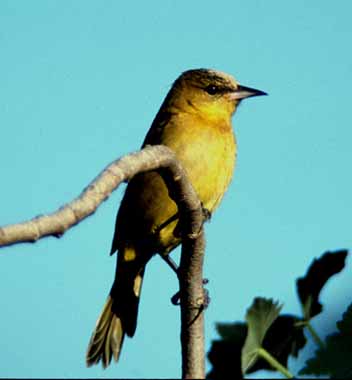 29
Nov-Dec 1999
29
Nov-Dec 1999
Blackburnian Warbler Dendroica fusca (insets) and
Orchard Oriole Icterus spurius (large photo) at Laguna Grande park, Seaside
Oriole photo 30 Nov 1999 © Bill Hill
Warbler photos 4 Dec 1999 © Don Roberson
Text by Don Roberson. Photos on this page are copyrighted by the photographers to whom they are attributed, and may not be reproduced in any form (including other web sites) without the express consent of the photographer.
 29
Nov-Dec 1999
29
Nov-Dec 1999
Blackburnian Warbler Dendroica fusca (insets) and
Orchard Oriole Icterus spurius (large photo) at Laguna Grande
park, Seaside
Oriole photo 30 Nov 1999 © Bill Hill
Warbler photos 4 Dec 1999 © Don Roberson
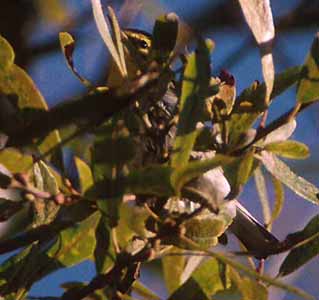
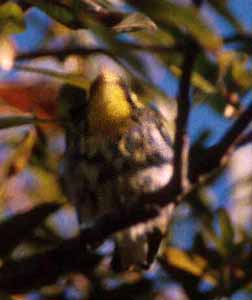 Steve Rovell found an odd warbler on 29 Nov that puzzled him; he identified
it within a couple days as a Blackburnian Warbler, likely an immature female.
It now appears the bird may winter, and it has since been confirmed by
numerous locals. While looking for this odd warbler on 30 Nov, Bill Hill
discovered a female-plumaged Orchard Oriole which also seems settling in
for the winter [Bill Hill took this great shot of "his" bird some thereafter].
This is yet another example of the "Patagonian Rest Stop Effect" (birders
searching for one rarity find another, and then another, and then another)
which led to the discovery of minor winter rarities Yellow & Wilson's
& Palm & Hermit warblers in the park, plus a Swamp Sparrow
Steve Rovell found an odd warbler on 29 Nov that puzzled him; he identified
it within a couple days as a Blackburnian Warbler, likely an immature female.
It now appears the bird may winter, and it has since been confirmed by
numerous locals. While looking for this odd warbler on 30 Nov, Bill Hill
discovered a female-plumaged Orchard Oriole which also seems settling in
for the winter [Bill Hill took this great shot of "his" bird some thereafter].
This is yet another example of the "Patagonian Rest Stop Effect" (birders
searching for one rarity find another, and then another, and then another)
which led to the discovery of minor winter rarities Yellow & Wilson's
& Palm & Hermit warblers in the park, plus a Swamp Sparrow
If the Blackburnian Warbler winters, it will be the second such record for the county. I found the first one on 29 Dec 1986, and that immature male remained until 22 March 1987, providing the first winter record for the entire state at the time. There are 11 prior winter records of Orchard Oriole in Monterey County.
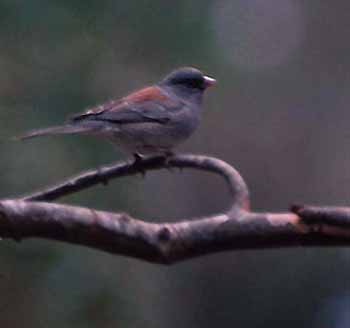 14
Nov 1999
14
Nov 1999
"Gray-headed" Junco Junco hyemalis caniceps in a Pacific
Grove backyard
Photo 14 Nov 1999 © Don Roberson
The "Gray-headed" Junco is the Rocky Mountain/Great Basin race of Dark-eyed Junco (it was once considered a separate species). California breeding populations exist in the White Mts. and on Clark Mt., both near the Nevada border, and wintering individuals are regular in the California deserts. These birds are quite scarce to the central and northern California coast. This individual shows characters of an apparently "pure" Gray-headed of the northern race caniceps (all pale bill is a feature of caniceps; "pure" since it lacked any hint of pinkish to flanks). Note the all soft-gray body plumage, the striking red back, and the black "mask" that includes the lores. It arrived with a flock of 30-40 juncos that included various "Oregon" types and some possible intergrades between races, during a gray overcast day that precluded good photos (this was handheld against the doorframe at 1/15 sec).
It is more common here to have "hybrid" or "intergrade" juncos than birds matching "pure" types. Introgression involving Great Basin races, sometimes involving genes of "Gray-headed" types and sometimes suggesting "Pink-sided Junco" J. h. mearnsi, is also fairly rare. "Pink-sided Junco" has never been documented in this county (although claimed several times); it is much rarer in California than caniceps (e.g., Grinnell & Miller, 1944, Distribution of Calif. Birds).
There are only five prior records from Monterey County of apparently "pure" Gray-headed Juncos, and only one documented: a specimen taken at Hastings Nat. Hist. Reservation on 5 Jan 1967 by John Davis. This is the first photographic record. There are two sight records at feeders in Monterey -- 27-31 Dec 1980 (Ron & Mary Branson) and 17 Nov-15 Dec 1984 (Will Russell) -- and another from a P.G. feeder 11-20 Mar 1982 (Margot Nelson). The final sight record is one seen at the Big Sur R. mouth 2 Oct 1994 (Craig Hohenberger; written details on file).
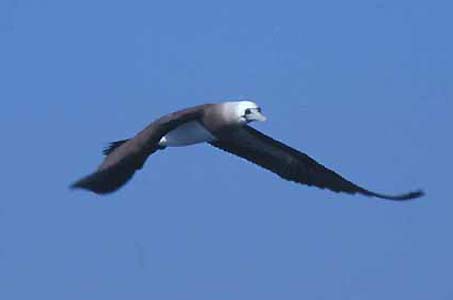 20 Oct 1999
20 Oct 1999
Brown Booby Sula leucogaster on Monterey Bay
at ~36°50'N, 122°05'W (7 nmi S of Santa Cruz SCZ)
photo 20 Oct 1999 © Richard Ternullo
This adult male, showing the pale head of the eastern Pacific race brewsteri,
was seen on a Jim Booker pelagic trip over the Soquel Canyon area of Monterey
Bay (in Santa Cruz Co. waters). Jim writes: "Cara Kelley, an intern at
the Big Sur Ornithology Lab, was chumming sardines from the stern to a
large congregation of gulls and shearwaters when she
spotted an unfamiliar bird. She ran to tell me at the bow of the boat
when a male Brown Booby came careening past us. "That's it! she said.
I yelled "Booby!" and Richard Ternullo, the captain, stopped the boat and
grabbed his camera. The bird came in to the chum line, landed briefly near
the stern, then flew away, never to be seen again. In this time,
I and many others on board had short but excellent views, and Richard managed
to take about seven photos."
One of those photos is reproduced here (thanks, Richard). Although this Brown Booby was in the Santa Cruz Co. portion of Monterey Bay (e.g., those portions of the Bay whose closest point of land is in that county), two other Brown Boobies were in Monterey County waters in recent months: a subadult that roosted at Castle Rocks, on the Big Sur coast, 22-27 July 1999 (Holly Gellerman; seen by many) and an adult female photographed by fisherman (Jerry Wettle, Joe Lucido) about 35 nmi WSW of Pt. Pinos on 23 Sep 1999 (prints graciously forwarded to me by Richard Ternullo).
Photos of two other recent Monterey County rarities are on-line on Joe Morlan's web site:
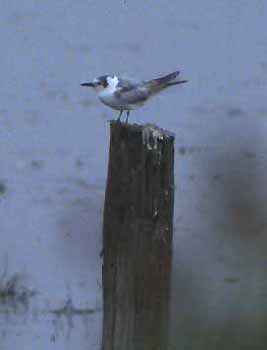 17 Aug-[6 Sep]-16 Oct 1999
17 Aug-[6 Sep]-16 Oct 1999
This dainty tern was first identified by Ed Kwater, a visiting East Coast birder leading a tour & now living in Florida, at midday on 6 Sep 1999 at a freshwater pond at Moonglow Dairy and adjacent to tidal Elkhorn Slough. A number of locals (including me) learned of its presence after getting off a boat trip that Labor Day, and the bird was still present when we arrived for leisurely studies. The bird's visits to Moonglow for the next six weeks ranged from erratic and sporadic, to days when it spent hours roosting on this pole or a nearby sandbar between bouts of foraging over the pond.
This photo (right) was taken by Ed Kwater on the day he discovered the tern, and is therefore the first documentary shot of this second California & first Monterey County record.
Evidence compiled over the autumn supports the belief that this bird had been present since 17 August when a non-breeding-plumaged "Black Tern" was reported by local birders. A birder chasing the "Black Tern" on 18 August noted the anomalous absence of black patches to the sides of the breast that day, but did not pursue the question further. Such a bird could not be a "Black Tern" and, since it behaved exactly as the White-winged did over its stay, it was undoubtedly the White-winged Tern. Those who saw the 17 Aug bird acknowledge that it could have been this bird, but have no specific details. [A claim of two "Black Terns calling back & forth to each other" as they flew over Elkhorn Slough on 18 August cannot refer to the White-winged which was silent during its entire visit, and never interacted with other terns.] I am of the opinion that it was present, but not identified correctly, since mid-August. This is consistent with the state of molt, as this species makes stops during migration to complete molt before arriving on wintering grounds in fresh basic plumage (Roselaar 1985).
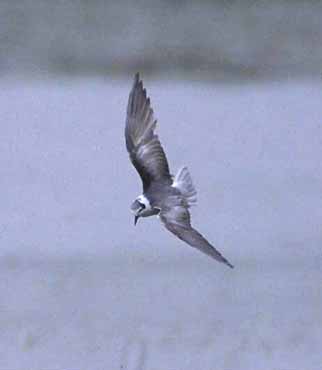 This very fine photo by Ron Branson (left) shows that the bird is in active
wing molt. It is growing in its inner primaries, and is also missing a
rectrix on the left side. The state of molt, plus the plumage pattern,
is consistent with a bird molting out of first basic (=first-summer); a
closely matching photo of this plumage appears in Olsen & Larsson (1995).
Note also (1) the contrast between darker mantle and whitish (actually
a very pale gray) rump; (2) the lack of any shoulder bar; (3) the square
tail which is very pale gray except for pure white outer rectrices; (4)
the short, delicate bill; (5) the complex head pattern in which round black
ear-patches are broader than the narrow black bar over the crown, the neat
little gray "ponytail" down toward the nape, and the finely streak forecrown;
and (6) blackish lesser wing-coverts. The bird also has reasonably long
crimson legs.
This very fine photo by Ron Branson (left) shows that the bird is in active
wing molt. It is growing in its inner primaries, and is also missing a
rectrix on the left side. The state of molt, plus the plumage pattern,
is consistent with a bird molting out of first basic (=first-summer); a
closely matching photo of this plumage appears in Olsen & Larsson (1995).
Note also (1) the contrast between darker mantle and whitish (actually
a very pale gray) rump; (2) the lack of any shoulder bar; (3) the square
tail which is very pale gray except for pure white outer rectrices; (4)
the short, delicate bill; (5) the complex head pattern in which round black
ear-patches are broader than the narrow black bar over the crown, the neat
little gray "ponytail" down toward the nape, and the finely streak forecrown;
and (6) blackish lesser wing-coverts. The bird also has reasonably long
crimson legs.
You can compare Branson's photo, taken 7 Sep when the tern was growing in its inner primaries, with my poorer shots (below) taken two weeks later (21 Sep). On each of my photos, I've placed a pointer on the right wing at the division between the new inner primaries (now fully grown, or nearly so) and the old outer primaries. These show reasonably nicely in the slides, and I hope he contrast is visible on this site. Other differences two weeks later were reduced blackish in the lesser coverts and molt in the head pattern, broadening the narrow gray "ponytail" to a broader blackish patch. Also, the tail now looks complete.
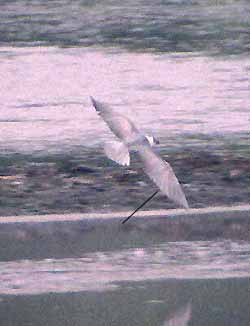
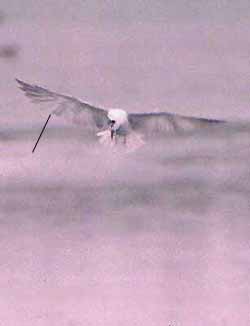
The tern became difficult to locate during its final week, and was last seen at mid-day on 16 Oct by a number of visiting birders, including Dave Trochlell of Idaho who kindly supplied his written details to confirm the final date of occurrence. Full day efforts to observe it on 17 & 18 Oct were unsuccessful, and it has not been reported since.
As noted above, this was just the second record for California; the first was an alternate plumaged bird in Arcata, Humboldt Co., in June 1996. The White-winged Tern's presence at Moonglow Dairy means that this private property, which we birders are able to visit through the kind permission of the owners (Louis & Carol Calcagno), has hosted a first state record (Smith's Longspur), two second state records (Little Stint & White-winged Tern), and a third state record (White Wagtail). Is there any other single site in the state -- away from SE Farallon I. -- that can claim such gaudy statistics?
Literature cited:
Olsen, K. M., and H. Larsson. 1995. Terns of Europe and North America. Translated by David A. Christie. Christopher Helm, London.
Roselaar, C. S. 1985. "White-winged Tern" in Handbook of the Birds of Europe, the Middle East, and North Africa (S. Cramp, ed.). Oxford Univ. Press, Oxford & New York.
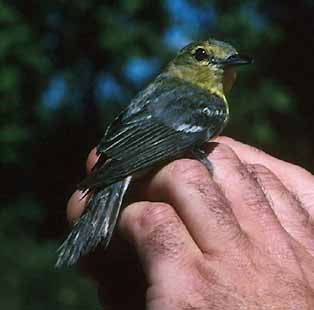 28
July-17 Sep 1999
28
July-17 Sep 1999
This very worn individual was netted and banded by the Big Sur Ornithology Lab, who graciously held the bird until a few of us could arrive to photograph & document it (special thanks to Tenaya Gordon for the call). Note the badly worn tail, the grungy look to the back, and its general dullness for what is usually a snappy-appearing bird. This is typical of worn birds in summer before their prebasic molt.
This individual remained along the Big Sur River for the summer, completing a full molt during August-September. When I saw it again in a mixed flock on 5 Sep, it was quite spiffy and crisp. Scott Terrill, who had seen it at close range the day before, told me it was still finishing wing molt at that time. The bird was recaptured by BSOL on 17 Sep at which thime its molt was nearly complete, and since it was never seen again, it must have left short thereafter.
This was only the second MTY record. The first was found dead on a Jon Dunn tour at Tierra Grande, almost ten miles up Carmel Valley, by Mary Yegella. It had been dead some time, dried out and being eaten by ants, but has been salvaged & retained as a specimen by the Pacific Grove Museum of Natural History. Presumably it had attempted to summer.
MTY's third record -- a very bright crisp bird, so presumably a hatch-year individual -- was discovered (by me!) at the Carmel R. mouth on 15 Oct 1999. It was unbanded (so cannot possibly have been the Big Sur bird). It remained with a mixed flock near the "green pipe" and was seen by many observers through 23 October. [Details on birding the Carmel R. mouth area are here.]
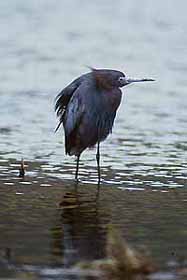 19
June 1999
19
June 1999
Little Blue Heron Egretta caerulea at Carmel Sur R. mouth
photo 19 June 1999 © Bill Hill
This adult appeared only briefly during the afternoon of 19 June in the "Odello Lagoon," the newly created wetland pond in the "south arm" of the Carmel R. mouth lagoon. It was seen to fly north at about 7:19 p.m. Bill Hill obtained this impressive shot during its short appearance.
This is only the fourth MTY record of Little Blue Heron. The first two
were white immatures in fall/winter, but the most recent record (preceding
this one) was also an adult (or near-adult) seen flying north past Pt.
Sur in April.
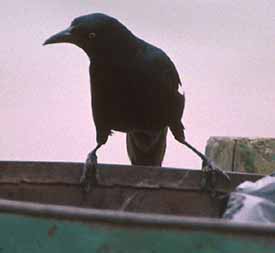 late
April to late June 1999
late
April to late June 1999
Nesting Great-tailed Grackles Quiscalus mexicanus at Roberts
Lake, Seaside
photo 27 May 1999 © D. Roberson
As everyone must know by now, Great-tailed Grackles are staging a dramatic range expansion in northern California. The first MTY record was just 5 years ago (8 May 1994 Carmel R. mouth; Jim Booker & Todd Easterla), but by last summer (18 Aug 1998) a group of seven together at Gonzales (K. Van Vuren) included apparent youngsters which might have hatched from local nests. The first confirmed nesting occurred this spring. Steve Bailey found a female in Seaside on 26 April; I discovered this male (checking out a garbage can in this shot) on 5 May displaying in a small bush right above MTY's first Heermann's Gull nest (see below)! By mid-May the male was consorting with two females. Dave Haupt saw one female nest-building in a reed bed on the east side of Roberts Lake on 7 May. On 9 May, I obtained evidence of two nests with young when each female was watched carrying insect food into two separate sites: one female's nest was in the E side reed-bed, but the other was in the center of the little bush on the western islet, and right above the two Heermann's Gulls nests! This means we have two first-confirmed breeding species in Monterey Co. nesting within a couple feet of each other. [Update: both nests fledged young by late June, and all grackles were gone by 4 July.]
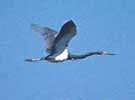 24
May-2 June 1999
24
May-2 June 1999
Tricolored Heron Egretta tricolor at Pt. Sur
photo 31 May 1999 © Don Roberson
This classic southern heron was discovered by Jim Booker and BSOL (=Big Sur Ornithology Lab) interns as it fed along the edge of a small temporary pool in the dunes below Pt. Sur (it seemed to be eating tadpoles). This private property can be accessed only with special permission, and active local birders were escorted to the bird through locked gates by BSOL personnel during its brief stay [the access here is so sensitive that word of this bird was necessarily limited to locals]. There is almost no heron habitat on the Big Sur coast, making the find even more unpredictable.
This was a first MTY record and not one that seemed particularly likely. There were only three prior northern California records, and all in the fall: at Hartson Reservoir, Honey Lake WMA, Lassen Co., 24 Aug-26 Sep 1971 (Manolis 1972 which includes a photo); at Santa Rosa Creek, Sonoma Co., 7-19 Nov 1992; and at Bodega Bay, Sonoma Co., on 17 Sep-1 Oct 1996 before appearing at Limantour Estero, Marin Co., from 6-7 Oct 1996.
Literature cited: Manolis, T. 1972. A Louisiana Heron in Northeastern California. Calif. Birds 3: 19-21.
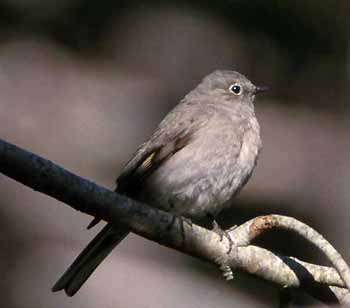 14-16
May 1999
14-16
May 1999
Townsend's Solitaire Myadestes townsendii in a Pacific Grove
backyard
Photo 15 May 1999 © Don Roberson
This unlikely yard bird appeared late on a Friday evening in my own P.G. yard (where Rita Carratello & I live on Grove Acre Ave.) while I was watching a Giants' baseball game. Suddenly it was in the "money tree" eucalyptus which was flowering and attracting a variety of warblers and Western Tanagers. The solitaire, though, fed almost exclusively on the ripe berries of a single Pyracantha bush; it stayed until those fruits were depleted. During its visit it drank from the bird bath, and just sat around quietly a lot (including in the neighbor's live oak). Most local birders who were interested saw this vagrant during its short stay.
While these quiet thrushes are possibly regular in small numbers in fall/winter in montane southern MTY, they are exceptionally rare in northern MTY and especially so on the Monterey Peninsula where there were only four prior records: three in Monterey (20 Dec 1952, 15 Jan-29 Mar 1969, 29 Dec 1969) and one at Hopkins Marine Station 27 Jan 1984. All these prior records were in winter; this 1999 bird was a spring migrant and by far the latest record for the county.
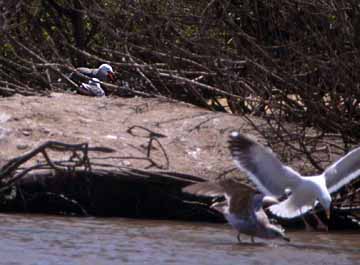 26
April into July 1999
26
April into July 1999
Heermann's Gulls Larus heermanni nest at Roberts Lake, Seaside
Photo of adult on nest 29 Apr 1999; photo below of two
chicks from that nest 27 May 1999, both © Don Roberson
This totally unexpected breeding attempt was discovered by Steve Bailey on 26 Apr 1999 while he was scouting for the BSOL birdathon. Two nests were being incubated on one or two small islands at the south end of this small lake near the Monterey Bay shore; Steve could see the adults turning eggs (one such nest is shown in the upper left of the photo; an adult sits on the nest while another attends beside it. Much courtship behavior and copulation was also witnessed.
A third nest was attempted (one egg in early May) along the berm on
the east edge of the lake, but it was adjacent to a jogging & bike
path, and was abandoned by mid-month (and the egg gone). At the south end
nests, two chicks were first seen at one nest by Alan Baldridge on 20 May,
and 5 were there by 28 May. By late June, 8 young were visible, and all
fledged in the period 1-3 July. This makes them the first successful nests
in the United States!
 Heermann's
Gulls is a nesting species of the Gulf of California. The primary colony
is on Isla Raza where 80,000 pairs breed; there are only two small colonies
on the Pacific coast side of the Baja Peninsula (Jehl 1976). In the United
States, Heermann's has attempted to nest just three times before, all in
California. In the summers of 1979, 1980, and 1981, a pair attempted to
nest on Alcatraz I. in San Francisco Bay, and up to 4 eggs were laid in
a season, but none hatched, possibly due to infertility (Howell et al.
1983). In May 1980, two pairs nested on a sea stack off Shell Beach, San
Luis Obispo Co., but these attempts were also thought to be unsuccessful
(Howell et al. 1983). A pair on Ano Nuevo I., San Mateo Co., hatched chicks
three years in a row (1994-1996), but each time they were lost to predatory
Western Gulls. In all cases, the nesting attempts were adjacent to nesting
Western Gulls. No Western Gulls nest at Roberts Lake, although they commonly
bathe and roost there.
Heermann's
Gulls is a nesting species of the Gulf of California. The primary colony
is on Isla Raza where 80,000 pairs breed; there are only two small colonies
on the Pacific coast side of the Baja Peninsula (Jehl 1976). In the United
States, Heermann's has attempted to nest just three times before, all in
California. In the summers of 1979, 1980, and 1981, a pair attempted to
nest on Alcatraz I. in San Francisco Bay, and up to 4 eggs were laid in
a season, but none hatched, possibly due to infertility (Howell et al.
1983). In May 1980, two pairs nested on a sea stack off Shell Beach, San
Luis Obispo Co., but these attempts were also thought to be unsuccessful
(Howell et al. 1983). A pair on Ano Nuevo I., San Mateo Co., hatched chicks
three years in a row (1994-1996), but each time they were lost to predatory
Western Gulls. In all cases, the nesting attempts were adjacent to nesting
Western Gulls. No Western Gulls nest at Roberts Lake, although they commonly
bathe and roost there.
Literature cited: Howell, J., D. Laclergue, S. Paris, W. I. Boarman, A. R. DeGange, and L.C. Binford. 1983. First nests of Heermann's Gull in the United States. West. Birds 14: 39-46.
Jehl, J. R., Jr. 1976. The northernmost colony of Heermann's Gull. West. Birds 7: 25-26.TOP
Page updated 9 Dec 1999